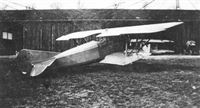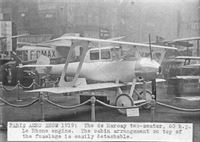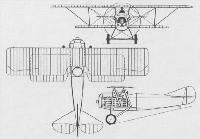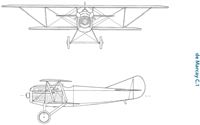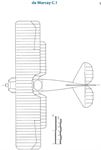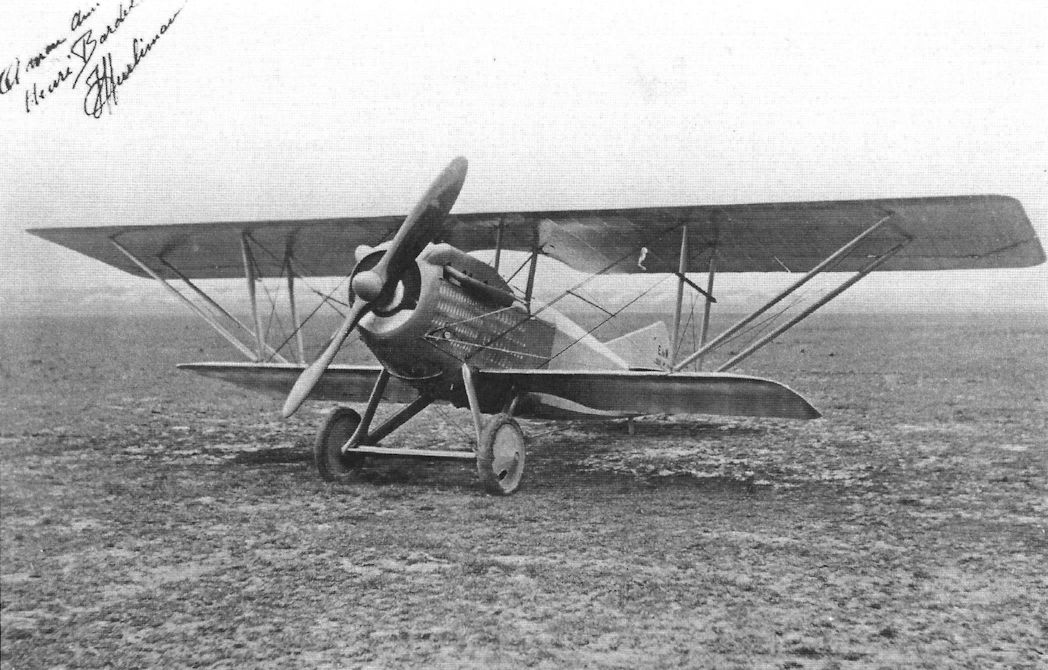
Описание
Страна: Франция
Год: 1919
Fighter
J.Davilla, A.Soltan French Aircraft of the First World War (Flying Machines)
Construction Aeronautique Edmond De Marcay
Edmond de Marcay opened two aircraft factories in Paris during 1916 and built SPAD aircraft under license. Perhaps drawing from his experience building the SPAD 7 fighter, de Marcay undertook to design a fighter to meet the C1 specification of 1918.
De Marcay 1 C1 and 2 C1
The C1 category called for a single-seat fighter to be armed with twin machine guns (either 7.7- or 11-mm) or a single 37-mm cannon with a single machine gun. Provisions were to be made for a photo-reconnaissance variant and also a monoplace protege. The payload was to be between 220 to 270 kg and the maximum ceiling was to be 9,000 m with a service ceiling of 6,500 m. A maximum speed of 240 km/h was requested. A large number of aircraft were submitted to meet the C1 specification. Those using the 300-hp Hispano-Suiza 8F were SPAD 18, 20, 21, and 22; Nieuport 29, Descamps 27, Hanriot-Dupont HD 7, SAB 1, Moineau C1, Semenaud C1, and de Marcay C1.
It had originally been intended that the de Marcay fighter be given a Liberty engine; this was designated the de Marcay 1. However, problems with the Liberty engine resulted in the aircraft being redesigned to take a 300-hp Hispano-Suiza 8Fb. This was designated the de Marcay 2. It was a conventional biplane with the top wing considerably longer than the lower. The extensions of the upper wing were braced by oblique struts fixed at the base of the interplane struts. There was a single bay of bracing struts and the ailerons on the upper wing were horn-balanced. The engine was mounted in an aluminum mount, the front of the fuselage was made of steel and the rear of wood. There were two synchronized 7.7-mm Vickers machine guns.
The aircraft was completed by 1919. The radiator was to have been mounted in the wing. However on production planes the radiator was mounted in the front of the engine and was circular. The engine was closely cowled and the camshaft covers were covered by full-length fairings. A jettisonable fuel tank was fitted between the landing gear struts. Balanced ailerons were on the upper wing only. Planned armament was two synchronized 7.7-mm Vickers machineguns.
The aircraft had an impressive performance and was the fastest at the 7 March 1919 concours. Bad weather prevented it from being evaluated at high altitude; therefore most of the testing occurred at 500 meters. Most of the comments in the test pilot’s reports were positive, but it was noted that the de Marcay 2 C1 had poor turning characteristics. Contemporary notes obtained from the Musee de I'Air show that the 2 C1 was considered adequate as a single-seat fighter. However, its climb rate was inferior to the Nieuport 29, and it was the latter which was selected for series production.
Records in the Musee de I'Air indicated that the de Marcay Type 3 was to have been a single-seat, single-bay biplane. This fighter would also have used the 300-hp Hispano-Suiza engine. The fuselage was to have been of all-metal monocoque construction with the radiator mounted in the front of the cowling. It is possible this design was a refinement of the de Marcay 2 C1 mentioned above. As far as can be ascertained, this type was never built.
Postwar, the de Marcay firm produced another sleek fighter, the de Marcay Type 4, which was rejected primarily because the shoulder-mounted wing inhibited the pilot's view. The Type 5 was a two-seat monoplane with a 370- or 450-hp Lorraine-Dietrich engine and a monocoque fuselage.
De Marcay 2 C1 Single-Seat Fighter with 300-hp Hispano-Suiza 8Fb
Span 9.25 m; length 6.62 m; wing area 25 sq. m
Loaded weight 1,704 kg; payload 339 kg
Maximum speed:
sea level 252 km/h
3,000 m 237 km/h
4,000 m 231 km/h
5,000 m 220 km/h
6,000 m 200 km/h
Climb to:
1,000 m 2 minutes
2,000 m 4 minutes 26 seconds
3000 m 7 minutes 26 seconds
4,000 m 12 minutes 3 seconds
5,000 m 18 minutes 16 seconds
Armament two 7.7-mm Vickers machine-guns
One built
Описание:
- J.Davilla, A.Soltan French Aircraft of the First World War (Flying Machines)
- W.Green, G.Swanborough The Complete Book of Fighters
- C.Owers French Warplanes of WWI. Volume 1: Fighters (A Centennial Perspective on Great War Airplanes 43)
- Журнал Flight
Фотографии
-
C.Owers - French Warplanes of WWI. Volume 1: Fighters /Centennial Perspective/ (43)
The Edmond de Marcay single-seater biplane, which, piloted by Lieut. Lebeau, at Villacoublay, attained speeds of 156 m.p.h. level, 147 m.p.h. at 10,000 ft., and 129 m.p.h. at 20,000 ft. It is fitted with a 300 h.p Hispano-Suiza engine, and has a span of 30 ft. 4 ins., overall length of 21 ft. 4 ins., and a useful load of 745 lbs. Its factor of safety is 14.
The De Marcay when first rolled out with a small spinner to the airscrew. -
C.Owers - French Warplanes of WWI. Volume 1: Fighters /Centennial Perspective/ (43)
The De Marcay C1 was a single-seat fighter with 300-hp Hispano-Suiza 8Fb.
Powered by a 300 hp H-S 8Fb engine, the prototype de Marcay 2 flew in 1919.
The De Marcay scout at Villacoublay for its official trials. The S.A.B 1C.1 is visible to the left background.Другие самолёты на фотографии: Bechereau (SAB) SAB 1 - Франция - 1918
-
C.Owers - French Warplanes of WWI. Volume 1: Fighters /Centennial Perspective/ (43)
The De Marcay scout at Villacoublay for its official trials. The S.A.B 1C.1 is visible to the left background.
-
C.Owers - French Warplanes of WWI. Volume 1: Fighters /Centennial Perspective/ (43)
The De Marcay has its airscrew removed in this photograph that appear to be taken at Villacoublay.
-
C.Owers - French Warplanes of WWI. Volume 1: Fighters /Centennial Perspective/ (43)
The De Marcay has its airscrew removed in this photograph that appear to be taken at Villacoublay. There is a Pfalz D.XII in the background with Breguet bombers.
-
C.Owers - French Warplanes of WWI. Volume 1: Fighters /Centennial Perspective/ (43)
Note the louvered panel under the fuselage of the C1. This view also shows the small pylon whose purpose is unknown. The rudder has the usual information but no tricolor stripes indicating that he machine was not built under a government contract.
-
C.Owers - French Warplanes of WWI. Volume 1: Fighters /Centennial Perspective/ (43)
Another view of the De Marcay C1 at Villacoublay. Note the small pylon at the starboard side of the centre section.
-
C.Owers - French Warplanes of WWI. Volume 1: Fighters /Centennial Perspective/ (43)
The compact build of the De Marcay is well shown in this view.
-
C.Owers - French Warplanes of WWI. Volume 1: Fighters /Centennial Perspective/ (43)
Post-war De Marcay entered the light aircraft field.
-
C.Owers - French Warplanes of WWI. Volume 1: Fighters /Centennial Perspective/ (43)
The De Marcay two-seater at the 1919 Paris Aero Show was a neat little rotary powered biplane with a removable canopy.








